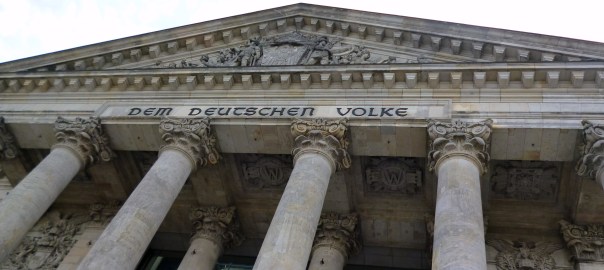I look out to my left, and I see Prussia. Straight ahead of me lies Weimar Germany. Somewhere behind me lies the Third Reich. Below me is Cold War Germany. To my right, modern-day Germany buzzes along.
No city experienced turbulence in the 20th century more than Berlin. With 5 different forms of government (imperialistic monarchy, democracy, fascist dictatorship, occupation & communist dictatorship) in less than 50 years, every time I visit a distinct feeling of this jigsaw history being forced together is impressed upon me.
The Brandenburg Gate, to the left of my position at the top of Lord Norman Foster’s Reichstag dome, is the symbol of old Prussia. Built by Prussian monarch Friedrich Wilhelm II, its victorious quadriga swiftly became established as a symbol of Prussian power and might after it was regained from Paris at the conclusion of the Napoleonic Wars. Bombed during the Second World War and used to host demonstrations during the Cold War, these 6 columns represent the inherent imperialistic foundations of the capital.
Interwoven amongst subtle memories of the kaisers (more prominent in the cathedral, where the mighty organ & lavish masonry of Friedrich I Barbarossa’s tomb seem to be superseded by memorials not to the hegemony of Prussia but to the oppression of its peoples by national socialists and communists) lie the hints of embryonic modern Germany. Between the downfall of Kaiser Wilhelm II following his 1918 abdication and the nefarious advent of the Nazis in 1933, Germany was a democracy, with proportional representation* and a functional parliament. The cries for this seem to be eternally etched onto the front of the Reichstag now – “DEM DEUTSCHEN VOLKE” (“TO THE GERMAN PEOPLE”), carved in 1916 as support for the monarchical autocracy dwindled, which, to the modern onlooker, evoke feelings of a wider significance. Throughout the 20th century, Germany rarely fully belonged to the German people, blocked by a warmongering kaiser, coldly efficient purist national socialists and administrations comprising of Soviet puppets.
Rightfully afraid of an upsurge of Neo-Nazis, the site of Hitler’s bunker during the Battle for Berlin is unmarked. It’s a car park now, not far from the Brandenburg Gate. Like the Residenzstrasse in Munich, simply standing on the street where some of the most pivotal events of Nazi history – the final days of the regime and its first steps towards the seizure of power respectively – is eerily poignant. Just imagining the realisation of the lost war, enactment of scorched earth policy, suicides & cremations which happened all around that point is strangely silencing. It’s the same with Prinz-Albrecht-Strasse-8. The headquarters of the SS. Beck, Canaris, Bonhoeffer, Oster…the names of the lions of the anti-Nazi resistance swim around in my mind as I stand above the excavations of their holding cells.**
The memorials to the victims of Hitler are dotted all around the city; the Holocaust Mahnmal a few seconds away from the Brandenburg Gate, the Jewish Museum (which actually also documents wider Jewish history), the Topography of Terror museum & various plaques. But what I find the most thought-provoking is not the extensive displays of little collections, but rather the places; the spots where Bormann’s skeleton was found, where the grand march of SS troops was held in 1933, where the various ministries ordered the subjugation of what was to become the Third Reich.
Other ‘memory spots’ are to be found in the centre of the city, where the Berlin Wall sliced the world in half overnight in 1961. A line of cobbles traces it outside the Reichstag, in other places a double white line or isolated blocks of it decorated with art and graffiti (East Side Gallery & Potsdamer Platz). The spot where Allied & Soviet tanks faced each other, either one with the capability to incinerate much of our planet through starting a nuclear war, is now a McDonald’s – says a lot about modern society. Checkpoint Charlie is a monument to souvenir hunting and photo opportunities, itself being a replica – the spot itself is far more vivid and evocative.
And although it was torn down in 1989, amidst worldwide festivity, the Wall continues to embody a discrepancy in Germany today. It is widely documented that the wage, employment and quality of life gaps between the former East & West Germany prevail, but I do not refer to this. This discrepancy is much wider, obscure and threatening. It is not the failure of Khruschev & Kennedy to become amicable diplomatically in the 1960s: it is the failure of society today to recognise that those differences are, at present, irreconcilable. The Wall may be down, but its footprint is still there. Although on the face of it East/West relations seem to be effective, in reality, as we are now beginning to witness in Crimea & the Eastern Ukraine, they are probably as dire as in 1961. The routing of capitalist/communist sympathisers may have ended with the death of the latter form of government in Russia, but the propaganda prevails. It is crucial to repair relations with Putin immediately if we are to avoid another century of European turmoil.
In the meantime, Berlin, within whose boundaries the German government even now is vying for non-belligerent solutions to the Ukraine issue, sits atop its marshy ground, the jigsaw city, with all the answers to the future locked within its streets.
*(which elicited great instability of government)
**This year marks the 70th anniversary of the 20th July plot to assassinate Hitler. I’m currently researching the extent of the opposition to the Nazis cocooned within their own regime, primarily within the secret service (Abwehr) which I hope to publish later this year.
